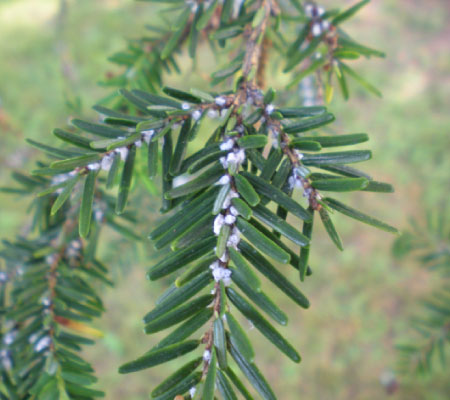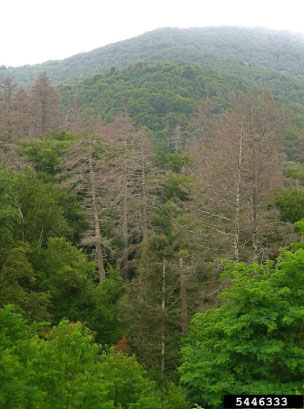Hemlock Woolly Adelgid
Hemlock woolly adelgid (Adelges tsugae) is a tree-killing insect that was accidentally introduced to eastern North America. It can become a threat to Wisconsin’s eastern hemlocks if it arrives here. Learn where this pest is now, what it looks like and how to prevent its spread into Wisconsin. More information is also available on the Wisconsin DNR's Hemlock Woolly Adelgid fact sheet.
Distribution
A pest of hemlock trees, hemlock woolly adelgid (HWA) is native to the Asian continent. HWA has not yet been found in Wisconsin, but has become well-established in several counties in western Michigan [exit DNR]. HWA currently ranges from northern Alabama/Georgia to southern Maine and from northern California to southeastern Alaska.
In Asia, hemlock woolly adelgid does not cause much damage to native hemlocks, even when adelgid populations are high. Asian hemlock trees have developed natural resistance over time, and there are natural enemies in place that help regulate HWA populations.
There is some evidence to suggest that HWA has been in western North America long enough for western hemlock tree species to develop resistance to the insect. Eastern hemlock trees do not have this resistance and are highly susceptible to HWA.
View a map [PDF exit DNR] showing areas where hemlock woolly adelgid is regulated.
How hemlock woolly adelgid spreads
At present, hemlock woolly adelgid is established in only part of eastern hemlock's range in North America. On average, the insect spreads about 15-20 miles per year, the result of dispersal by wind, people, birds and other animals. HWA survives very cold temperatures in its native range. However, HWA spread and population buildup appear to be slower in colder parts of the northeastern U.S.
Signs and Symptoms
The white, cottony egg sacs of the hemlock woolly adelgid can be seen on the undersides of hemlock branches at the base of needles year-round. Hemlocks that are infested will develop needles that yellow and eventually fall off, leaving dead, bare branches and thin crowns. Infested trees decline and die over several years.
It is important to report trees with suspected HWA. Check out this guide [PDF exit DNR] for more identification tips. If you suspect that a tree is infested, please contact the Wisconsin Department of Agriculture, Trade and Consumer Protection (DATCP) Pest Reporting Hotline at 1-866-440-7523 or DATCPPestHotline@wi.gov. Individuals reporting possible HWA are encouraged to send clear, close-up photos to help with identification. For more information, visit the DATCP HWA webpage [exit DNR].
Biology
Adelgids are related to aphids and have a similar, complex life cycle. HWA (Adelges tsugae) is parthenogenic, which means all individuals are female and produce offspring without mating. In North America there are two generations per year.
In the spring, adelgids hatch from a white, cottony egg sac that may contain as many as 300 eggs. The adelgids crawl around until they settle at the base of a needle and begin to suck nutrients from the twig. Their saliva is toxic to the tree and eventually causes the needles to drop and the twigs to die back. They will usually remain at that feeding site for the rest of their lives. Each adult produces an egg sac in June and July.
The second generation hatches from these eggs, begins to feed and then enters a dormant period for the rest of the summer. Being a cool weather species, feeding starts again in October and continues as weather conditions allow. These immature adelgids become adults during late winter and early spring. Some of these adults are wingless and remain on hemlock trees. Others fly away to lay their eggs on spruce trees. There are no suitable spruce species in North America, so these offspring do not develop successfully here.
Impact in Wisconsin
Eastern hemlock (Tsuga canadensis) is the only hemlock species present in Wisconsin, and it has little resistance to HWA. Heavy infestations can kill trees within four to 10 years, during which time infested trees will likely be further weakened by other insects and diseases. Although some trees recover, the mechanisms that allow for this are poorly understood. Most trees eventually die. More information on eastern hemlock in Wisconsin is available from the University of Wisconsin-Green Bay Herbarium.
Hemlock is a long-lived, ecologically important tree that provides habitat for many wildlife species. It also helps to control stream erosion and is an important ornamental tree. In the eastern United States, heavy hemlock mortality has often resulted in altered forest structure, degraded fish habitat and increased invasion of non-native plants.
Prevention
Hemlock woolly adelgid is classified as a prohibited species in Wisconsin's invasive species rule NR 40, Wis. Admin. Code.
The best way to prevent or slow the spread of hemlock woolly adelgid is to make rigorous efforts to avoid moving it to new areas. Public awareness and cooperation play important roles, and quarantines and mandatory inspections are also used to prevent hemlock woolly adelgid’s spread on potentially hazardous hemlock wood and products. Suspect materials include hemlock nursery stock, logs and firewood from eastern states where hemlock woolly adelgid is present. Learn more about the hemlock woolly adelgid quarantine in Wisconsin [exit DNR].
Management
In infested areas, the insect can be managed on individual trees through the use of insecticides, horticultural oils and insecticidal soaps. Keeping ornamental hemlocks well-watered and healthy can help them to withstand an infestation.
In forests
Widespread insecticide treatment in forests is not practical and salvaging dead or dying trees is the most common management technique. Some infested states apply limited insecticide treatments at sites where hemlocks have especially high ecological value.
Biological controls
In North America there are a few native predators but they do not eat enough of the adelgids to prevent damage to hemlocks. One approach to managing hemlock woolly adelgid has been to introduce natural enemies from the insect's native range in Asia. One predatory beetle (Sasajiscymnus tsugae) has been mass reared and released in the eastern U.S. Its adults and larvae prey on hemlock woolly adelgid and help to reduce its numbers. Two species of predatory Laricobius nigrinus beetles have also been released at many locations in eastern states.


